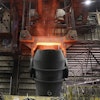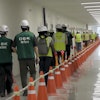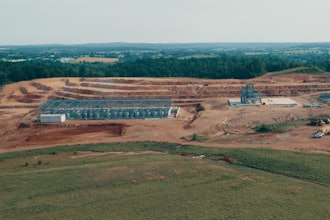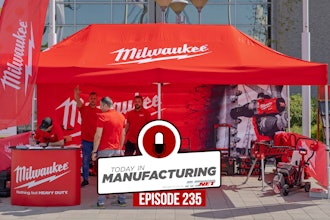Otherwise, the physical process of assembling a tank is much the way it was 100 years ago: Sheets are cut from steel plates of varying thicknesses and, like sections of a ship's hull, curved to match the desired tank diameter. Other components - fixed and floating roofs, top and bottom rings, man-ways, vents, ladders, hatches, stairways and others - are custom-made by hand and heavy machinery. All parts are trucked to the erection site, where a field crew assembles the tank.
Field crews usually include eight to 10 men - boilermakers by trade, but referred to as "tankees" for their special skills - who work four 10-hour days. They arrive with all construction material they need in a 40-ft. mobile work trailer and an open flatbed trailer. Materials include a diesel generator, welding units and supplies, electric cables, safety equipment, hand tools, scaffolding and an assortment of standard parts. A crane is rented and construction begins, usually on a previously prepared concrete foundation.
Virtually all modern chemical and petrochemical tanks use a false bottom to allow leak-detection equipment to be placed underneath. This is typically constructed first, then steel side sheets are lifted into place around it by the crane, guided by the crew foreman. As sections are completed, they are tack-welded into place, then permanently welded horizontally by the automatic welder and vertically by hand. As levels rise, scaffolding is constructed on the inside of the tank by the crew. This is accomplished by welding temporary brackets on the inside of the shell pieces before they are put in place. Scaffold supports are slipped into the brackets from inside the tank, and heavy, 12-ft. wooden planks are placed on top. From the scaffolding, the foreman guides remaining shell sheets into place, and welding is completed. A roof is constructed last. Painting and other final surface preparation is usually sub-contracted.
Fisher Tank's assistant safety director Cory Evans calls tank building "one of the hardest jobs in the country." This is especially true in summertime, he says, when "you're actually standing on a frying pan with leathers on," totally cut off from cooling breezes.
As a niche manufacturer, Fisher Tank only builds flat-bottom, above-ground steel tanks - nothing underground, and nothing constructed from other materials (such as fiberglass or concrete). In Fisher's market area (all states east of the Mississippi) tank maintenance accounts for most of the company's work in Northeastern states, while new construction dominates in other areas. Its two offices - Chester, PA, and Lexington, SC - are strategically located to support both functions. Much of the maintenance work Fisher conducts involves retrofitting and updating older petrochemical storage tanks to meet state and federal regulations that require leak-detection systems. Much of its new-construction business involves building water tanks and standpipes for growing communities in the Southeast and Midwest.


















